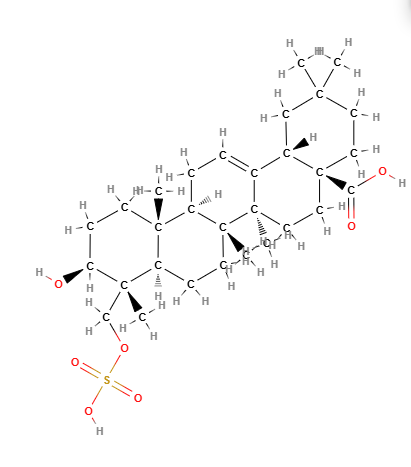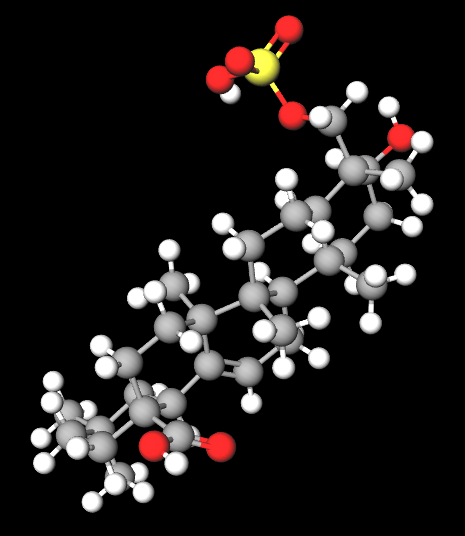![]() Triterpenes
Triterpenes
Rating : 8
| Evaluation | N. Experts | Evaluation | N. Experts |
|---|---|---|---|
| 1 | 6 | ||
| 2 | 7 | ||
| 3 | 8 | ||
| 4 | 9 | ||
| 5 | 10 |
Pros:
Anti-inflammatory (1)0 pts from admin
| Sign up to vote this object, vote his reviews and to contribute to Tiiips.Evaluate | Where is this found? |
| "Descrizione" about Triterpenes by admin (19557 pt) | 2024-Jul-17 09:45 |
| Read the full Tiiip | (Send your comment) |
Triterpenes are a class of natural compounds composed of six isoprene units, resulting in a 30-carbon skeleton. They are found in various plant species and are valued for their beneficial properties, making them popular in various applications, particularly in the fields of cosmetics, personal care, and medicine.
Chemical Composition and Structure
Triterpenes have a diverse range of structures, often categorized into different types such as squalene, lanosterol, and various triterpenoid saponins. These compounds are characterized by their hydrophobic nature and complex cyclic structures.
Physical Properties
Triterpenes typically appear as crystalline solids or oils, depending on their specific structure and derivation. They are generally hydrophobic and may require solvents like ethanol for incorporation into various formulations.
Production Process
The production of triterpenes involves several steps:
- Harvesting and Selection: Plants rich in triterpenes, such as ginseng, licorice, and birch bark, are harvested and selected for quality.
- Cleaning: The harvested plant materials are thoroughly cleaned to remove dirt and contaminants.
- Extraction: The cleaned plant materials undergo an extraction process using solvents such as ethanol, hexane, or supercritical CO2 to obtain the triterpenes.
- Filtration: The extracted solution is filtered to remove any solid residues and impurities.
- Purification: The triterpenes are purified through processes such as chromatography to isolate the desired compounds.
- Drying: The purified triterpenes are dried to produce a fine powder or concentrated oil.
- Packaging: The final product is packaged under controlled conditions to ensure stability and purity.
Applications
- Cosmetics: In the cosmetics industry, triterpenes are valued for their anti-inflammatory, antioxidant, and skin-soothing properties. They are commonly included in formulations of creams, serums, and lotions to enhance skin health and appearance (2).
- Personal Care: Triterpenes are used in various personal care products such as shampoos, conditioners, and body lotions for their protective and nourishing properties.
- Medicine and Pharmaceuticals: Triterpenes have potential medicinal applications due to their anti-inflammatory, antimicrobial, and anticancer properties. They are used in dietary supplements, topical ointments, and herbal medicines (2).
Environmental and Safety Considerations
Environmental Impact: The production of triterpenes generally has a moderate environmental impact. Sustainable harvesting practices and the use of eco-friendly extraction methods can help minimize the overall impact.
Safety: Triterpenes are considered safe for topical use in the concentrations typically employed in consumer products. However, it is essential to ensure that the compounds are free from contaminants and comply with regulatory standards. Allergic reactions are rare but cannot be excluded.
 |  |
Bibliografia__________________________________________________________________________
(1) Agra LC, Ferro JN, Barbosa FT, Barreto E. Triterpenes with healing activity: A systematic review. J Dermatolog Treat. 2015 Oct;26(5):465-70. doi: 10.3109/09546634.2015.1021663. Epub 2015 Apr 20. PMID: 25893368.
Abstract. The purpose of this review was to systematically evaluate the literature on the efficacy of triterpenes for wound healing. We searched for original studies in the Medline, SCIDIRECT and LILACS databases published from 1910 to 2013. For each study, the title, abstract and full article were evaluated by two reviewers. We identified 2181 studies; however, after application of the inclusion and exclusion criteria, only 12 studies were subjected to further review. In surgical wounds, the triterpenes induced a reduction in time to closure, and this effect was reported in virtually all wound types. Triterpenes also modulate the production of ROS in the wound microenvironment, accelerating the process of tissue repair. Triterpenes may also induce cell migration, cell proliferation and collagen deposition. Although the pharmacological effects of triterpenes are well characterized, little is known about their effects in cells involved in healing, such as keratinocytes and fibroblasts. In addition, the lack of studies on the risks associated with the therapeutic use of triterpenes is worrisome. Our study reveals that triterpenes seem to favor wound healing; however, toxicological studies with these compounds are required. Taken together, these findings show that the triterpenes are a class of molecules with significant promise that leads for the development of new drugs to treat skin injury.
(2) Valdés K, Morales J, Rodríguez L, Günther G. Potential use of nanocarriers with pentacyclic triterpenes in cancer treatments. Nanomedicine (Lond). 2016 Dec;11(23):3139-3156. doi: 10.2217/nnm-2016-0251.
Abstract. Ursolic, oleanolic and betulinic acids are representative pentacyclic triterpenoids found in various plants and fruits. Despite having marked antitumor potentials, the very poor water solubility of these triterpenes hinders treatment development. Nanotechnology can enhance solubility, stability, bioavailability and phytochemical delivery, improving the therapeutic efficiency of triterpenes. This review focuses on the formulation, characterization and in vitro/in vivo evaluation of several delivery nanosystems used to enhance the physicochemical properties of ursolic, oleanolic and betulinic acids.
Laszczyk MN. Pentacyclic triterpenes of the lupane, oleanane and ursane group as tools in cancer therapy. Planta Med. 2009 Dec;75(15):1549-60. doi: 10.1055/s-0029-1186102.
Abstract. Today cancer treatment is not only a question of eliminating cancer cells by induction of cell death. New therapeutic strategies also include targeting the tumour microenvironment, avoiding angiogenesis, modulating the immune response or the chronic inflammation that is often associated with cancer. Furthermore, the induction of redifferentiation of dedifferentiated cancer cells is an interesting aspect in developing new therapy strategies. Plants provide a broad spectrum of potential drug substances for cancer therapy with multifaceted effects and targets. Pentacyclic triterpenes are one group of promising secondary plant metabolites. This review summarizes the potential of triterpenes belonging to the lupane, oleanane or ursane group, to treat cancer by different modes of action. Since Pisha et al. reported in 1995 that betulinic acid is a highly promising anticancer drug after inducing apoptosis in melanoma cell lines in vitro and in vivo, experimental work focused on the apoptosis inducing mechanisms of betulinic acid and other triterpenes. The antitumour effects were subsequently confirmed in a series of cancer cell lines from other origins, for example breast, colon, lung and neuroblastoma. In addition, in the last decade many studies have shown further effects that justify the expectation that triterpenes are useful to treat cancer by several modes of action. Thus, triterpene acids are known mainly for their antiangiogenic effects as well as their differentiation inducing effects. In particular, lupane-type triterpenes, such as betulin, betulinic acid and lupeol, display anti-inflammatory activities which often accompany immune modulation. Triterpene acids as well as triterpene monoalcohols and diols also show an antioxidative potential. The pharmacological potential of triterpenes of the lupane, oleanane or ursane type for cancer treatment seems high; although up to now no clinical trial has been published using these triterpenes in cancer therapy. They provide a multitarget potential for coping with new cancer strategies. Whether this is an effective approach for cancer treatment has to be proven. Because various triterpenes are an increasingly promising group of plant metabolites, the utilisation of different plants as their sources is of interest. Parts of plants, for example birch bark, rosemary leaves, apple peel and mistletoe shoots are rich in triterpenes and provide different triterpene compositions.
Yazdani M, Béni Z, Dékány M, Szemerédi N, Spengler G, Hohmann J, Ványolós A. Triterpenes from Pholiota populnea as Cytotoxic Agents and Chemosensitizers to Overcome Multidrug Resistance of Cancer Cells. J Nat Prod. 2022 Apr 22;85(4):910-916. doi: 10.1021/acs.jnatprod.1c01024.
Abstract. The detailed mycochemical analysis of the n-hexane extract of Pholiota populnea led to the isolation of four new lanostane diesters, named pholiols A-D (1-4), together with an acyclic triterpene, (3S,6E,10E,14E,18E,22S)-2,3,22,23-tetrahydroxy-2,6,10,15,19,23-hexamethyl-6,10,14,18-tetracosatetraene (5), ergosterol (6), and 3β-hydroxyergosta-7,22-diene (7). The isolation was carried out by multistep flash chromatography, and the structures were elucidated using extensive spectroscopic analyses, including 1D and 2D NMR and MS measurements. The isolated metabolites (1-6) were investigated for cytotoxic activity against Colo205 and Colo320 colon adenocarcinoma and nontumoral MRC-5 cell lines. Among the tested compounds, ergosterol (6) showed substantial cytotoxic activity against all cell lines with IC50 values of 4.9 μM (Colo 205), 6.5 μM (Colo 320), and 0.50 μM (MRC) with no tumor cell selectivity. A P-glycoprotein efflux pump modulatory test on resistant Colo320 cells revealed that pholiols A (1) and B (2) and linear triterpene polyol 5 have the capacity to inhibit the efflux-pump overexpressed in the cells. Moreover, the drug interactions of triterpenes with doxorubicin were studied by the checkerboard method on Colo 320 cells. Pholiols B (2) and D (4) interacted in synergistic and acyclic triterpene 5 in a very strong synergistic manner; the combination index (CI) values at 50% of the growth inhibition dose (ED50) were found to be 0.348, 0.660, and 0.082, respectively. Our results indicate that P. populnea is a promising source for finding new triterpenes with significant chemosensitizing activity on cancer cells.
| Sign up to vote this object, vote his reviews and to contribute to Tiiips.EvaluateClose | (0 comments) |
Read other Tiiips about this object in __Italiano (1)
Component type: Natural Main substances: Last update: 2024-07-17 09:28:12 | Chemical Risk: |


